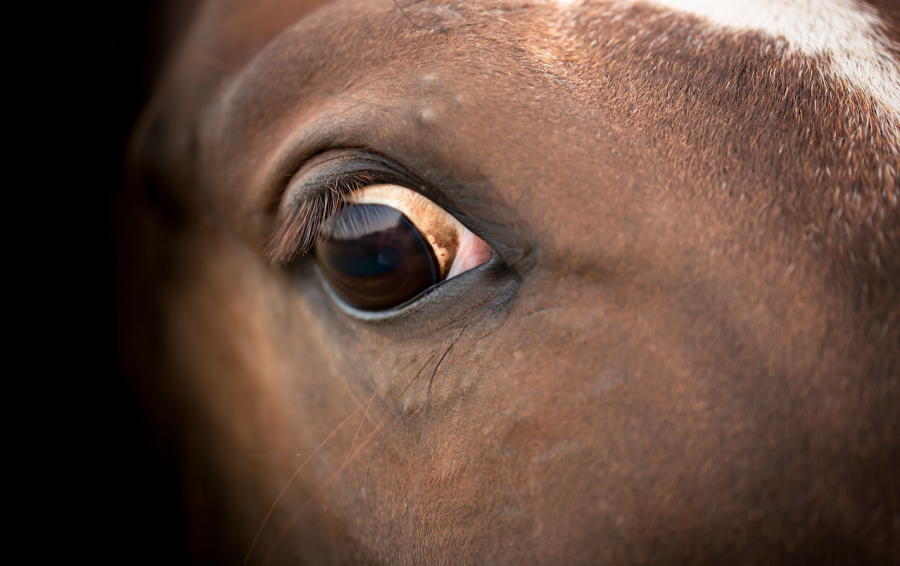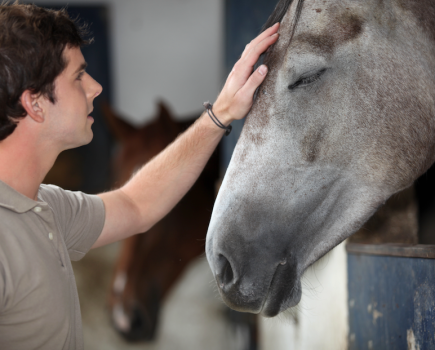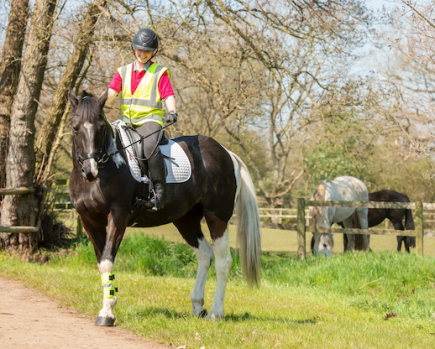According to esteemed equestrian professional Richard Maxwell, all horses are naturally phobic (scared of things) to some degree, ranging from the almost bombproof characters to scared horses that spook at every leaf.
Horses learn by experience so if they undergo something frightening or painful, as a prey animal this memory will stand out because they can’t afford to let it happen again. This in turn affects behaviour, because the horse is trying to tell you that they are scared.
“Horses are one-time learners and in these situations they remember the fear and pain. For some it only needs to be one or the other, but if you have both it’s a double whammy,” says Richard.
“It all comes down to self-preservation, and the memory of the stress means a horse will resist repeating the experience.
“The way the horse sees it he has the right to use his size, strength and speed to avoid it and that’s when he starts to become unruly, so we have to show him through training that these things aren’t an advantage.”
Signs a horse is scared
The eye is one of the first indicators of a scared horse. Not only does the shape of the eye change when a horse is frightened, but the sclera (white of the eye) also starts to show (see main image, above) and their behaviour often changes.
In some horses, the sclera is always visible, especially in coloured horses and ponies with lots of white on their faces. Generally, the more white we see, the more aroused the horse is.
You will also notice the position of the ears in a scared horse. Not forward and not back; just behind the midway point, turned to focus on something looking like they are ready to flee (this is their natural flight behaviour kicking in).
Helping a scared horse
Tackling a phobia in a scared horse isn’t simply a matter of exposing your horse to the thing they’re scared of in the hope they get used to it.
“If you are scared of snakes and I tied you up and covered you with them it wouldn’t help, and it’s the same for horses,” states Richard. “If a phobia overtakes your emotions and you can’t cope, then you just can’t cope — the adrenaline is surging and you can’t do anything other than panic, which in a scared horse is when the flight instinct takes over.
“We have to show the horse that although we can’t make something scary go away or stop it happening, we can teach him to manage his reaction and cope better, so they stay safe.”
The trick is finding something your horse is mildly scared of and carefully desensitising them to it without triggering a surge of adrenaline. A scared horse needs a chance to realise that it’s not going away, but equally whatever they’re scared of isn’t hurting them.
Desensitising a scared horse
It’s very important to understand, before you start desensitising your horse, that things may get worse before they get better.
“Even a scared horse will mostly do what you ask,” says Richard. “The next time you ask he’ll probably say ‘thanks but no thanks’, and it’s here the horse’s behaviour begins to deteriorate.
“Then you get the ‘up yours’ response where he’ll try and bring his size, speed and strength into play.
“The moment it gets animated is the start of change — if you stop then you’ll have done more harm than good so stay calm and see it through,” continues Richard.
“The next time you try it the horse has given it some thought and will go along with what you want. He realises his behaviour changed nothing, he didn’t gain anything from it and sees it’s to his benefit to make that behaviour redundant.”
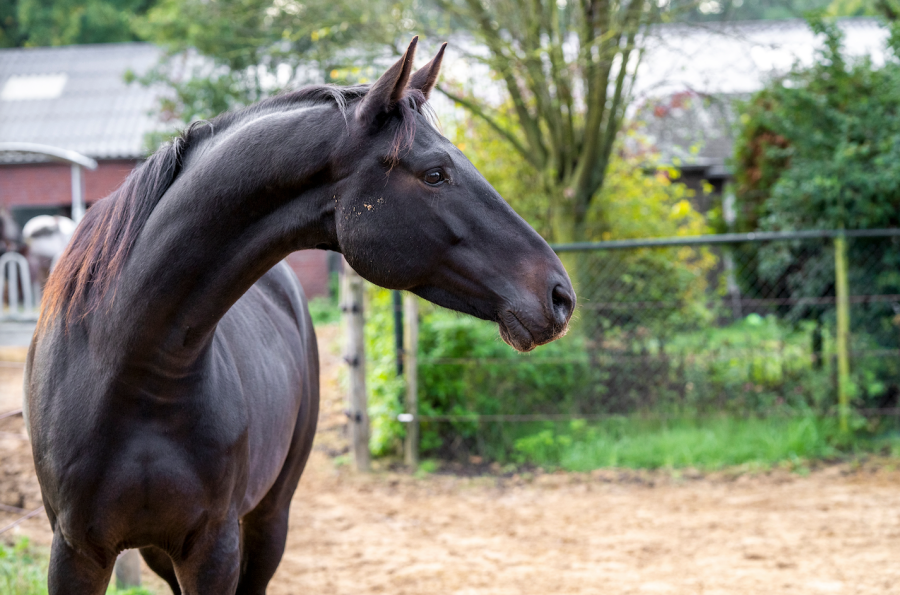
Managing a scared horse
Richard advises that if you can train your horse to lower their head, change their frame and place their feet where you want them on demand, you can control a scared horse in panic situations.
The first stage is to ensure you have full control of your horse in all directions and at all speeds, and you can move from one to another seamlessly.
Richard explains how to do this below:
Step 1: stepping forward and back
In a safe enclosed space, start by asking your horse to back up and move forwards — don’t be surprised if they initially resist. The classic stance will be the front feet together and hind feet spread wide. Your horse might try and use their size and strength by bracing themselves to resist what you’re asking.
You want the horse to roll back and forward without interruption, so be clear and to the point and they will soon learn that changing their physical or emotional position is inappropriate and will do what you’re asking.
Step 2: stopping and turning
Once you’ve mastered moving backwards and forwards smoothly, practise stopping and changing direction on the lunge. The ability to change direction quickly and efficiently counters the horse’s natural strength. They might resist at first, but don’t rush it and you’ll get there. Ideally you’ll master this in walk, trot and canter while lunging, but don’t worry if you only manage walk and trot.
Step 3: facing a fear
“When you’ve mastered both these stages you can start to desensitise your horse to a particular fear,” says Richard.
In a horse who is spooky, for example, Richard uses an exercise that involves rattling a noisy bottle while working with the horse on the ground. In horses who start using evasive behaviours, such as napping, after being scared by something they have seen, there is a way to help them confront their fear and stop being a scared horse.
Help for a needle-shy horse
Every horse will need an injection at some point, a regular tetanus booster for example, but some horses are so scared of needles that they put themselves and their handlers at risk.
I can relate to this one, as I don’t like needles and injections either!
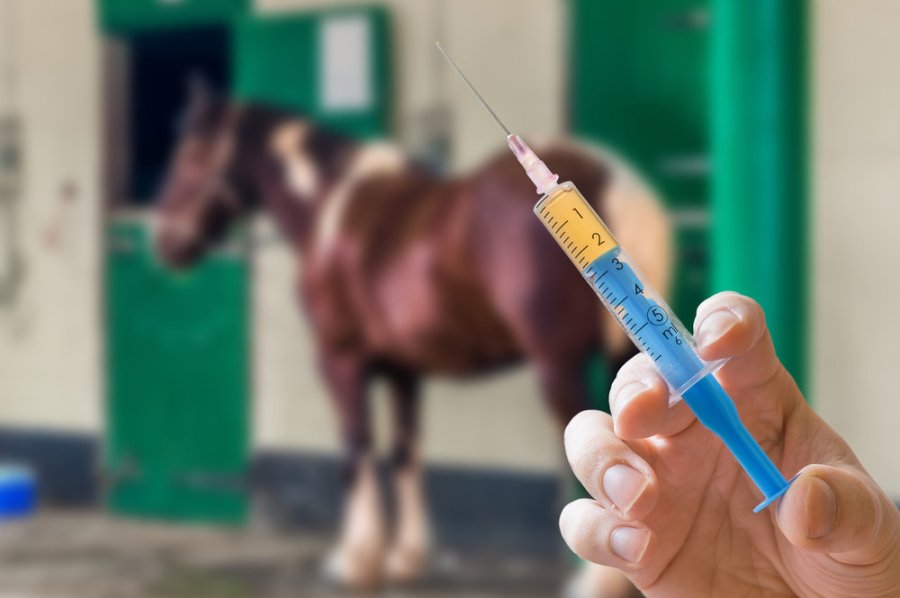
“When injections are given into the neck, a horse may become tense and stressed and move away from the needle. As reactions become more severe, they may rear, or, if the needle is placed on the rump, they might kick out or buck,” says vet Mark Bowen.
“Each time the horse moves, the needle (the adverse stimulus) is taken away, which acts as the reward that then reinforces the behaviour.
“A scared horse may become increasingly agitated, but it’s important to remember they aren’t being naughty; they are just responding to a needle in a manner they’ve learned.
“Increasing the amount of restraint, or even punishing them, will only exacerbate the distress and again further amplify the unwanted behaviours.”
You need to break the cycle that reinforces the learned behaviour, but teaching a new behaviour associated with injections can take a considerable amount of time.
It’s important that any lessons involve positive reinforcement, rather than punishment or excessive restraint.
“Any form of behavioural modification relies upon giving perfectly timed rewards. In many cases, breaking the cycle of behaviours will require professional input from a vet or equine behaviourist,” adds Mark.
“Practices such as clicker training can be particularly useful, as they clearly identify the ‘good’ behaviour that is being rewarded.”
Practice at home
I had a needle-shy horse and the older she got, the worse it became. It made a ‘quick’ routine appointment for things like an equine flu jab a nightmare!
In the end, a vet left me with an empty syringe with the needle removed so that I could ‘practise’ injecting her.
She was a clever mare and at first all the behaviours she used to get away from the vet holding a needle — rearing, running backwards and ears pinned back with her teeth bared — were used on me.
The difference, though, was that I had time to keep trying.
Solving the problem
This same mare was injected by a vet a few months later without any problems after I did the following:
- First of all, I left the syringe on the floor outside her stable door every day so that she could see it and it became a normal part of her every day life.
- Next, I placed it on top of the stable door. After some snorting, she touched it and eventually knocked it on the floor. We played that game for about a week.
- I held the syringe in my hand while grooming and tacking up. By now she would sniff it, but would cock an ear sideways if that hand got a bit too close to her neck.
- This progressed to me pinching a bit of her neck, trying to mimic the feel of an injection being given. At this stage, the syringe was still in my other hand.
- At random intervals, especially while grooming, I would rub the syringe all over my mare’s body as her confidence grew. She never reacted strongly to me doing this; in fact, she quickly got bored and paid no attention.
- The final stage was pinching the mare’s neck while holding the syringe in the same hand. She didn’t react at all. I did this the morning of her next flu booster and the vet couldn’t believe she was the same horse — she has stood calmly for her injections ever since. Success! I continued to expose my mare to the syringe regularly, and it was a process that took months, but it worked.
Help for a horse scared of the farrier
Being shod is a noisy experience and there are some interesting smells (hot metal on hoof wall, for example) going on too. So it’s no surprise that some horses are scared.
According to leading trainer Jason Webb of Yourhorsemanship, there are things you can do to help a horse become more confident with the farrier.
“Before you start, make sure you can replicate the noise of the farrier’s tools and that you’re able to move around while making this noise,” says Jason.
“First of all, check you can control your horse’s hind end so he faces towards you on command, then start making the noise.”
Depending on how your horse reacts, adjust your actions as follows:
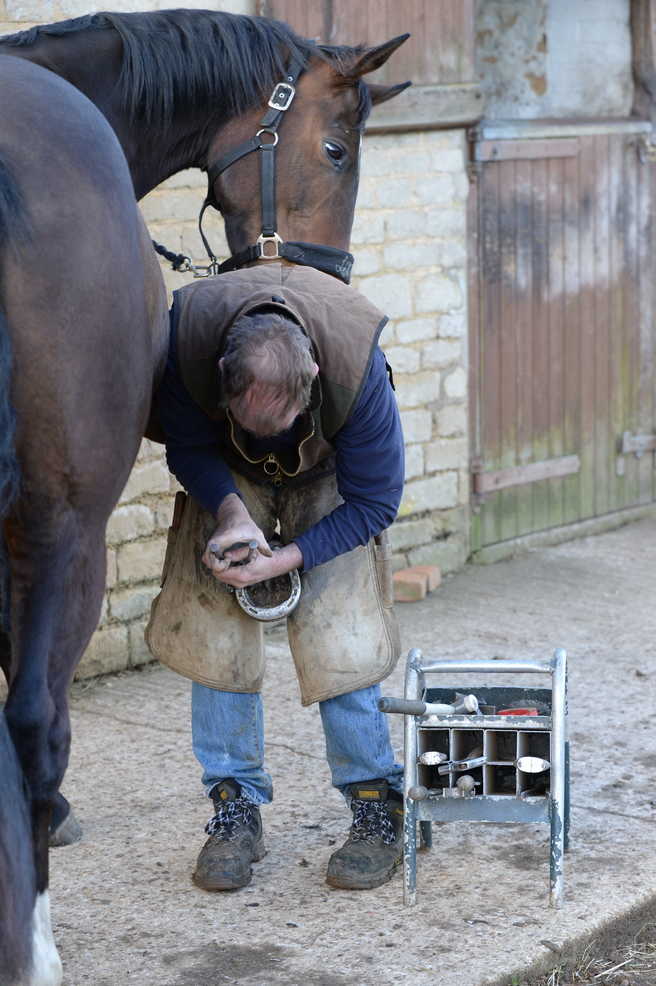
If the horse tries to run:
- Stop making the noise.
- Control their hind end to help them relax while facing you.
- Repeat this until your horse wants to stay facing you, even when you’re making the noise.
If the horse stays facing you, but keeps moving:
- Keep making the noise until your horse stops moving.
- Stop making the noise and take them for a walk to relax.
- Repeat until the horse doesn’t move when you make the noise.
- Progress to letting them sniff and make contact with the object making the noise.
- Take it a step further and progress to placing the object in contact with the horse’s neck and moving it down over their back, ensuring you don’t leave the object on your horse for too long.
- Repeat, starting at their nose until your horse is comfortable with contact from the object.
“Once the horse is comfortable with this, progress to what I call ‘moving with distraction’,” says Jason.
“If a horse is truly relaxed with the object, they should be calm while being led as the noise is being made. They may be reluctant at first, in which case try to get one step and stop making the noise. Repeat until you’re getting fluent steps forward.
“It’s also a good idea in this situation to get your horse used to strangers, including the farrier, without making any noise or attempting to do anything with your horse’s feet.”
Help for a horse scared of fly spray
There are a few reasons why horses don’t like fly spray.
- They have very sensitive skin — they can feel a fly land on their body, after all — and so may not like the sensation of being sprayed.
- Some sprays have a strong smell, which can be off-putting.
- Many sprays make a noise, triggering a scared horse.
The goal behaviour when applying fly spray is to have a relaxed horse who stands still and stays calm.
Teaching them to accept the spray must begin at the point where they are uncomfortable with the process, and gradually progress from there.
So if your horse is happy for you to spray from 5m away, start there. Or if they’re fine with you spraying their back but not their neck, start with their back.
“You want to reward any curiosity or exploratory behaviour towards the spray bottle,” says equine behaviour scientist Abigail Allen of Mind In Motion Equestrian. “When the horse has done the right thing, let them know by saying ‘good’ at the exact moment and then reward them with a treat.
“I love positive reinforcement, but rules must be in place for it to be successful. It is important that the horse understands the clear criteria for getting a treat; for instance, by saying ‘good’. If the reasons for your rewards aren’t clear it can evolve into unwanted behaviours [such as biting].”
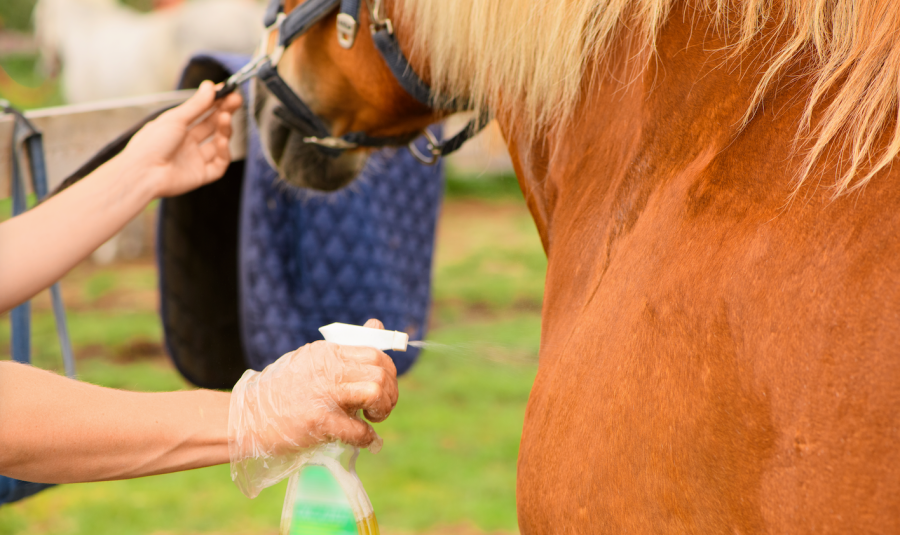
Take your time
Abigail advises doing training to work through a fear response for 10 minutes a day, six days a week. This is long enough not to be too hard work and repetitive enough to let the horse learn.
“Once the horse is comfortable with being sprayed, you can then gradually decrease it to one session a week, as the fear can relapse,” she says.
It’s important to always finish training on a positive note.
“Your horse will tell you when they’ve had enough for the day. They’ll disengage from the training and become more aware of their environment,” says Abigail.
“You might find they are brilliant one day but have gone backwards the next. That’s normal. They might be fatigued by being asked to do the same thing over and over.
“It’s exhausting working through anxiety — which humans understand — but we sometimes overlook this in our horses.”
Short-term solution
While training a horse to accept being sprayed, it is best to remove it from their daily life and applying fly protection in a different way.
“I recommend using a sponge or a soft grooming brush to apply fly spray while you address the horse’s fear response,” advises Abigail. “You don’t want to jump the gun. Just because they accepted it once doesn’t mean they are ready for it every day.”
As I said in the opening line of this article, the eye is one of the first indicators of a scared horse. Learn to read their body language and facial expressions; you’ll find you become a more understanding owner with a better bond with your horse.
Good luck!
All images © Your Horse Library/Kelsey Media Ltd & Shutterstock

